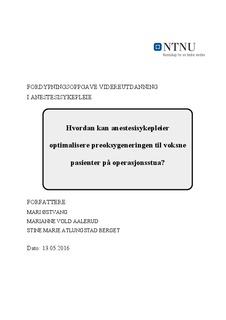| dc.contributor.advisor | Svarthaug, Lars Aune | |
| dc.contributor.author | Østvang, Mari | |
| dc.contributor.author | Aalerud, Marianne Vold | |
| dc.contributor.author | Berget, Stine Marie Atlungstad | |
| dc.date.accessioned | 2016-09-29T09:25:37Z | |
| dc.date.available | 2016-09-29T09:25:37Z | |
| dc.date.issued | 2016-09-29 | |
| dc.identifier.uri | http://hdl.handle.net/11250/2411720 | |
| dc.description.abstract | Bakgrunn: Vi har valgt å skrive denne oppgaven på bakgrunn av forskjeller i preoksygenering av pasienter på operasjonsstua. Forskjellene ligger i bruk av FiO2 80% eller 100%. Pasienter vi møter på operasjonstua er alle enkeltindivider, hvor utfordringer i forhold til luftveishåndtering ligger i både anatomiske og patologiske årsaker. Vi ønsker å se på anestesisykepleiers muligheter for å optimalisere preoksygenering. Er det mulig å gjøre dette prosedyrestyrt, eller bør det tilrettelegges for den enkelte pasient? Metode: Oppgaven er et litteraturstudie hvor vi har gjort systematiske søk i Cinahl, Pubmed og Oria. Vi har gjort pyramidesøk på McMasterPlus/Helsebiblioteket og usystematiske søk i Google Scholar. Resultat: Leiring og forskjellige non-invasiv ventilasjon (NIV) metoder har vist en effekt i forhold til pasienters funksonelle residual kapasitet (FRC), reduksjon i dannelse av atelektaser, forbedring av preoksygenering og forebygging av postoperative lungekomplikasjoner (PORC). Konklusjon: Ut fra vårt litteraturstudie finner vi det ikke anbefalt å redusere FiO2 fra 100% til 80% under preoksygenering. Voksne, friske pasienter tolererer atelektasene som oppstår grunnet høy FiO2 relativt godt. Samtidig er det flere andre faktorer som er årsak til atelektasedannelse, eksemplevis operasjonstid og leiring. Risikopasienter vil og ha utbytte av 100% FiO2 da pasientsikkerhet og sikker apnetid må sees på som prioritert foran risiko for atelektasedannelse og PORC. Viktigheten av god leiring til den enkelte pasient er av stor betydning for optimalisering av preoksygeneringen. NIV anses som et godt tiltak til risikopasienter som står i fare for rask desaturasjon under apnetiden. | nb_NO |
| dc.description.abstract | Background: We have chosen to write this thesis on the basis of differences in preoxygenation of patients in the operating theater. The differences are in the use of FiO2 80% or 100%. Patients we meet in the operating theater are all individuals, where challenges in airway management lie in both anatomical and pathological reasons.We want to look at the nurse anesthetist opportunities to optimize preoxygenation. Is it possible to do this procedure governed, or should it be adapted to the individual patient? Method: This thesis is written as a literature study. We have made systematic searches of Cinahl, Pubmed and Oria, and together with a pyramid search on McMasterPlus/Health Library and unsystematic search in Google Scholar. Result: Deposition and various non-invasive ventilation techniques (NIV) has shown efficacy to patients functional residual capacity (FRC), reduction in the formation of atelectasis, improving preoxygenation and in the prevention of postoperative pulmonary complications (PORC) . Conclusion: Based on our literature review, we find that it is not recommended to reduce FiO2 from 100% to 80% during preoxygenation. Healthy adult patients tolerate atelectasis that occurs due to high FiO2 relatively well. Other factors as time of surgery and deposition are most likely to cause absorption of atelectasis as well as high FiO2. Patients at risk will benefit 100% FiO2 when patient safety and safe-apnea must be seen as a priority over risk of absorption atelectasis and PORC. The importance of good positioning of the patient is of great importance for optimizing preoxygenation. NIV must be considered as a good approach to patients who are at risk of rapid desaturation during apnea time. | nb_NO |
| dc.language.iso | nob | nb_NO |
| dc.subject | Apne | nb_NO |
| dc.subject | Altelektaser | nb_NO |
| dc.subject | Anestesiinnledning | nb_NO |
| dc.subject | Preoksygenering | nb_NO |
| dc.subject | Postoperative komplikasjoner | nb_NO |
| dc.subject | Pulmonary atelectasisc | nb_NO |
| dc.subject | Anesthesia induction | nb_NO |
| dc.subject | Preoxygenation | nb_NO |
| dc.subject | Postoperative complications | nb_NO |
| dc.title | Hvordan kan anestesisykepleier optimalisere preoksygeneringen til voksne pasienter på operasjonsstua? | nb_NO |
| dc.title.alternative | How can a nurse anesthetist optimize preoxygenation to adult patients in the operating theater? | nb_NO |
| dc.type | Student paper, others | nb_NO |
| dc.subject.nsi | VDP::Medical disciplines: 700::Health sciences: 800 | nb_NO |
| dc.source.pagenumber | 44 | nb_NO |
